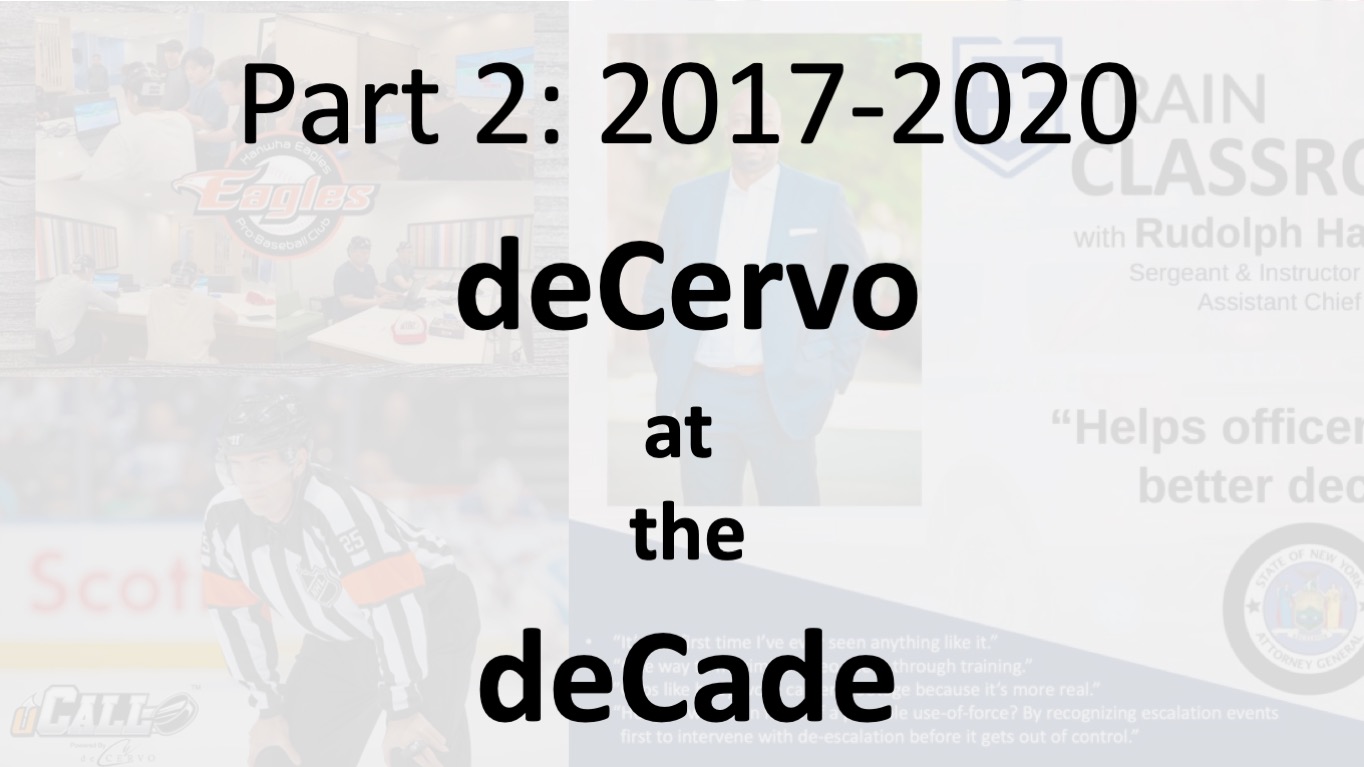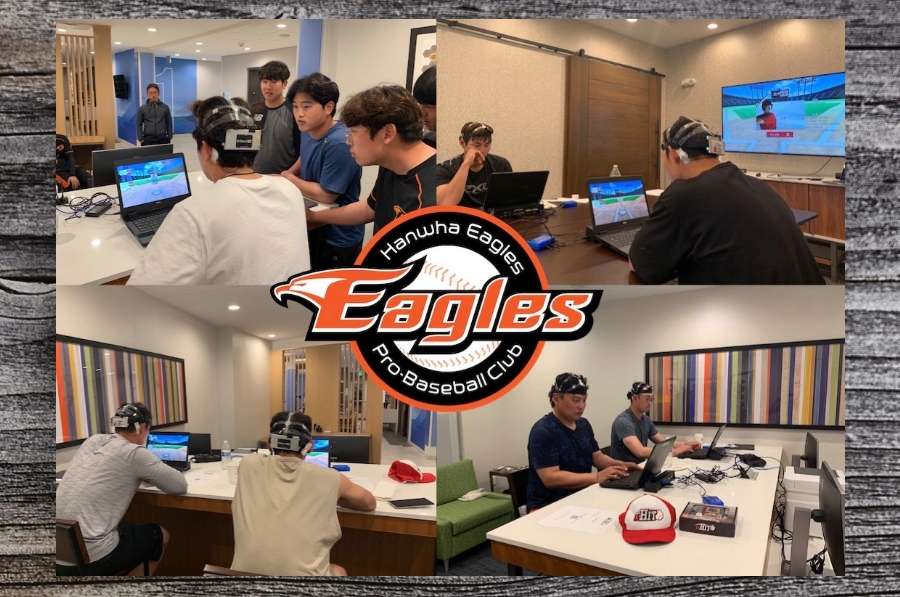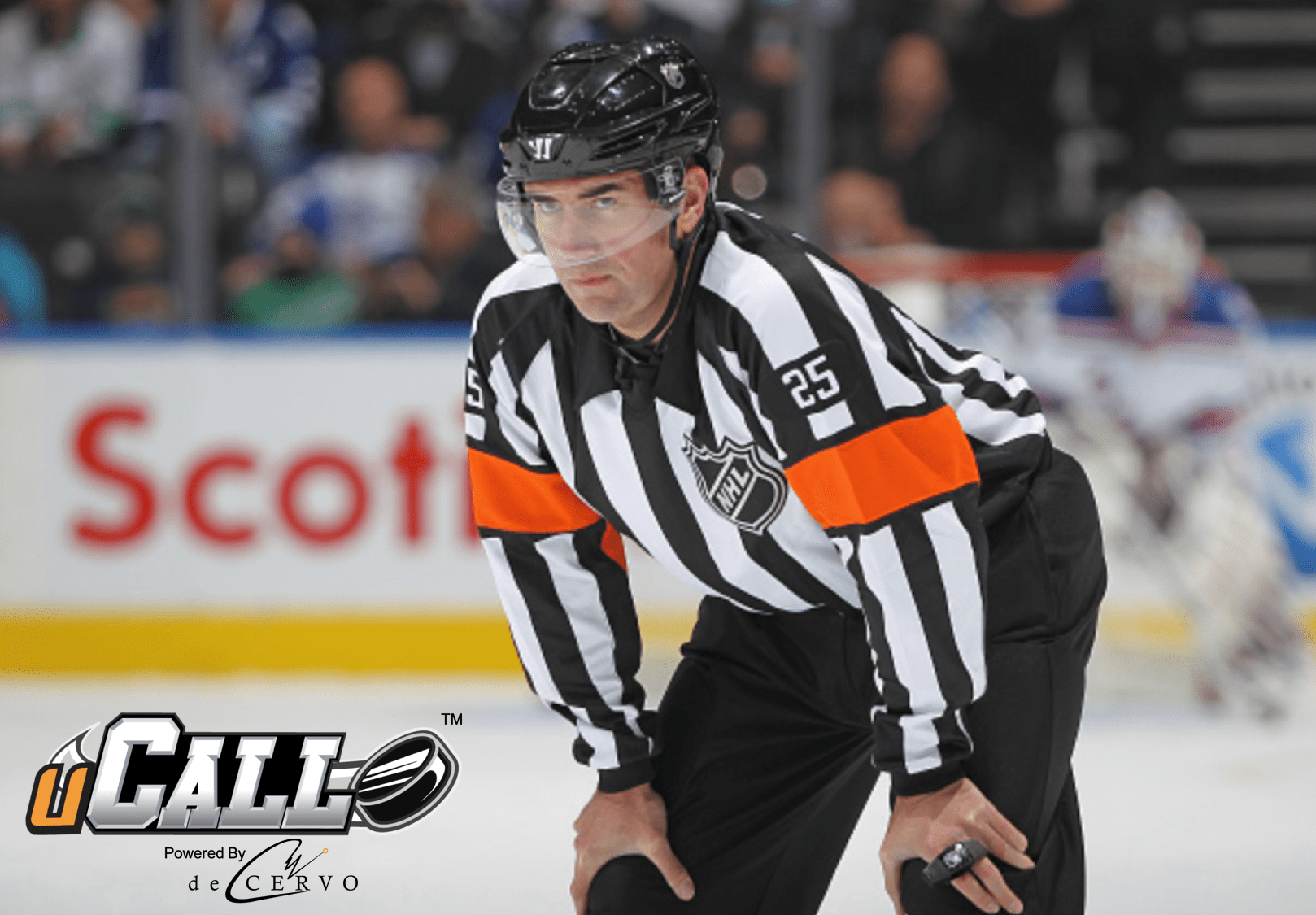Part 2 of deCervo At The deCade
10 Years of Progress
Decision training apps for real-world applications
February 21, 2024

Part 2 of deCervo At The deCade: Accelerating Cognitive Development
A Look Back on Decision Training History We’ve Made
This month marks 10 years, a full decade, of our company. Here, we look back at what we’ve done and where we’re going. From our founding in 2014, to our early work in Major League Baseball (2015-2018), we will review our early accomplishments. From our sustained work for the US Army (2017-present), to our integration into the National Hockey League’s referee / linesmen development (2018-present), we will examine our enterprise-scale research and apps. Along the way, we will highlight continuing accomplishments in baseball and fastpitch softball. Finally, we will review our first product suite outside of sports, the law enforcement / police training tool, e-TRAIN (2021-present). We will see where its early impacts have been and where it has yet to help police and community safety in the US.
For each of these stops on the deCervo deCade, we will revisit news articles and case studies of our own. We will track how brain science discoveries we made led to the products we help people with every day.
Overview
Part 1
In part 1 of deCervo at the deCade, we covered 2014-2016 (see here). For 2014, we highlighted the first signs in our scientific research that decision training may be possible. We talked about our initial mission to provide neuroscience-informed scouting and our initial company name, “Neuroscout.” For 2015, we recounted our rebrand to “deCervo” and our change in focus to decision training. In that same year, we recounted our early work in Major League Baseball and the continuation of our scholarly research. Finally, for 2016, we recounted our capstone scientific findings and first signs of hitter development potential in pro baseball.
Part 2
In part 2 of deCervo at the deCade, we cover 2017-2020. For 2017, we look at the beginning to our research for the US Army and our first client results in pro baseball. In 2018, we survey the early accolades and challenges from scaling our approach to hitter development. We also look at the start of our 6-year relationship with the NHL Officiating Department this year. Finally, we note the first full year of what became multi-year research for the Army. In 2019, we cover new directions in baseball / softball informed by our previous season. We recount first steps in making a product for police training. And we recount the organizational shift that happened in the NHL’s development of officials that put our product directly at the center.
Part 3
Later in part 3 of deCervo at the deCade, we will cover 2021-present. For 2021, we will survey initial results in pro and college baseball and softball for our customize training program, uHIT Custom. In 2022, we will see continued progress with baseball / softball. And we will highlight first clients in police training, along with expansion in referee training. In 2023, we will note our first measurable effects on player valuation in pro baseball. We will also highlight the 3-year research grant awarded by the Army Research Office. Finally, for 2024, we will look ahead to the new developments rolling out this year and what expectations we have for their impact.

2017: US Army and First MLB Org Clients
In 2017, we started our first contract with deCervo’s best customer of the last 10 years. In Part 2 of deCervo at the deCade, we look at the research we did in support of the US Army. We also look at our early rollouts and challenges of delivering accelerated development in pro baseball.
Enterprise-Scale Challenges in MLB
We tested two hypotheses we had when we entered the baseball market. The first was whether baseball hitters would train their hitting on a phone. The second was whether the hitters would navigate themselves suitably through our training platform. Inaugurated officially as “uHIT” in 2017, we now had a baseball-specific tool that began our transition away from direct brain measurement. But would it work in the culture of pro baseball in the MLB or other countries?
We had two significant pro baseball clients this year. One was an org based in Pennsylvania from the MLB. The other was from Seoul, Korea of the Korean Baseball Organization. Both orgs gave us substantial pushback on the use of a phone to evaluate and train hitters. They were not of the same mind as Mike Chernoff from the Cleveland Guardians (see Part 1 here). Rather, they thought that there would be more benefit to allowing hitters to train while in their natural batting stance. To meet their needs, we developed the now-discontinued uHIT Virtual Remote (see here).
The Virtual Remote innovation got us over the hump of getting buy-in from the hitters. The problem later arose though that we could not see if the hitters were navigating the training options available to them properly. To speed up repetitions, hitters used the same account when the Virtual Remote was set up at one batting station. As a result, all org hitters’ data became jumbled and we had limited ability to gauge if they were learning in uHIT. We needed a better way to evaluate and guide individual hitters.

National Pastime In Support of National Defense
The Army Research Office accepted our research plan to the Neurophysiology of Cognition and Human Dimension Program. In this research, we would examine ways to better link changes seen in uHIT to those happening on-field for hitters. We would be researching the national pastime (baseball) in support of our national defense (the US Army). As it happens, the Army spends a lot of money on training and preparation. But they are not always certain how training platforms, like virtual reality translate to in-the-field outcomes. Our research plan would address this problem. We would use baseball as the testbed to see if training platforms could be optimized to better facilitate real-life outcomes.

2018: The NHL, Scaling Hitter Development and the Army
The early traction in Major League Baseball helped us get attention in our first sport outside baseball. The National Hockey League (NHL) began its 6-year engagement with us this year. Our early traction in some MLB orgs helped us scale up in these and other orgs in 2018 too. Our first year of research for the Army saw the initial investment by the Federal Government paying off. In this section of part 2 of deCervo at the deCade, we look at each of these developments.
Transition to Officiating Development
Back in 2015, the Columbia University Entrepreneurship initiative (see here) connected us with David Stern. A JD holder from the school, Stern was the Emeritus Commissioner of the NBA when we met him. He interviewed us at an event hosted by Columbia that year (see here). His advice to us was, “forget the players because the refs need this.” Specifically, he meant that the accelerated development we were pitching to players would be better served for referees, umpires and the like. After initial progress with his old league, he called up a friend who used to work for him down the street. In the late David Stern’s world, “down the street” meant down 5th Avenue in New York. And “a friend who used to work for him” meant Gary Bettman, the NHL Commissioner.
After a successful pitch to Mr Bettman, we were given our mission by NHL Executive VP, Colin Campbell. He told us, “I just want fewer bad [sic] calls.” The word he used for “bad” expressed enough urgency for us to realize our approach to accelerate development could help the NHL. This was the beginning of our years-long work with Stephen Walkom, Director of Officiating (see more here). That season was the first for uCALL for Officials, our app to accelerate development of hockey officials (see here). uCALL is perhaps the most important development as a company covered in part 2 of deCervo at the deCade.
Scaling Hitter Development
This season, two hitters demonstrated a usage pattern that would lead us to develop uHIT Custom (see more here). The hitters were in one MLB organization at the high A Minor League affiliate. They preferred using uHIT Plus (see here) on their personal phones. You can see more about these hitters from case studies back then (here) and 5 years later (here). Each of these hitters adjusted the settings (see here) to suit the problems they self-diagnosed for themselves at the plate.
But these hitters were a small minority of all hitters in this org and our repeat client org in PA. By and large, hitters did not change app settings to challenge themselves and address their hitting skills. In the PA MLB org, there weren’t any hitters as targeted to their strengths and weaknesses as the two hitters linked above. As a result, we saw a broad degree of monotonous usage, likely due to a team policy to “put in the reps.” Sadly, this was a missed opportunity to help the hitters learn these skills. We took that feedback seriously as we thought of the next iteration of uHIT to make it accelerate hitter development. What we settled on would become uHIT Custom (see video below). It would customize to each hitter’s strengths and weaknesses. That’s where we saw the most potential to help hitters.
This conclusion would prove significant for the last year in part 2 of deCervo at the deCade.
Army Research, 1st Year
Our first year of research with the Army allowed us to demonstrate our capability as a small business to have the Federal Government as a customer. We demonstrated our ability to execute applied research. And we began to illustrate how those findings might translate to Army application. We were introduced this year to our first potential Army customer outside research, the Picatinny Arsenal in New Jersey (see here)

2019: Part of the NHL, New Directions in Policing and Baseball
2019 proved to be a year of transitions at deCervo. This chapter in part 2 of deCervo at the deCade highlights the opportunity we saw with new clientele outside baseball (the NHL). In doing so, we also identified a non-sports application for our approach to development: police training. The exciting thing about this field is that it would allow deCervo to make a fundamental contribution to our society. We continued our work in baseball, now with fastpitch softball added to uHIT (see here). But we would alter fundamentally how we trained hitters this year and implement our first field test of it (see here).
Becoming Part of NHL’s Professional Development
The NHL Exposure Combine happens each August at the KeyBank Center in Buffalo, NY (see more here). In 2019, we established the template that would be the basis for our continued role in the NHL’s officiating development to the present day. We gave assessments in the NHL Standard of play-calling to all prospective officials at the Combine (see video below). From that group, the NHL would select a subset of junior officials whose development they would guide further. They would do that with our product, uCALL for Officials (see more here). By the 2023-24 season, this process would be responsible for 100% of new NHL Officials accelerating their development with uCALL (see case study here).
Foundations of Our Police Training
We completed a limited project with the Anchorage Police Department at the start to the year. In that project, our goal was to teach de-escalation techniques to police officers (see more about these techniques here). By the summer, the NYPD (see here) was interested in a new product we called “e-TRAIN.” Originally designed as escalation (and de-escalation) training, e-TRAIN became a prototype tool the NYPD considered for restructuring its “stop and frisk” program (see more here).
The instruction sergeant and chief we met at NYPD were impressed. In a short time, Rudolph Hall (Retired NYPD and NYAG, Sergeant and Assistant Chief, see here) and John Cosgrove (NYPD Chief, see here) became an integral part to e-TRAIN. Chief Cosgrove has been a primary police advisor on e-TRAIN’s Basic Curriculum (see here). AC Hall (Ret.) has been a close advisor on curriculum and the e-TRAIN Classroom in-person instruction (see more here). The below interview with AC Hall introduces these foundations of e-TRAIN and their need in policing:
Identifying Our Value in Baseball
The early signs in baseball were that our biggest value would be in player development. Specifically, if we could develop hitters to realize more hits and runs on-field with few strikeouts then it would be a game changer. Out of 2016 and 2018, we saw early signs of meeting this goal. But it was still a challenge for MLB orgs and players to manage these goals. Only a handful of hitters were willing enough technologically to explore uHIT’s many functions (see more here).
By Fall 2019, we had constructed a prototype for what would become uHIT Custom. The Fresno State Softball hitters under their coach, Matt Lisle (see more here), would use uHIT Custom for Softball (see here) in their fall training practice. The innovation with uHIT Custom was that hitters would automatically get more or less difficult pitches based on their uHIT Assessment (see here). Subsequent re-assessments in the app would determine whether to tune up or down the difficulty.
Several hitters gravitated to the training by themselves. And we learned a valuable lesson that to get team-wide adoption, the coach has to drive the importance of the training. Still, multiple hitters from Fresno State Softball integrated the uHIT Custom training into their routines. The following spring we were able to evaluate results with enough games before COVID stopped the season. The Fresno State Softball hitters hit with a 35-point OPS increase after using uHIT Custom (see here). All-Conference Shortstop, Schuyler Broussard, was the most dedicated and accomplished user of uHIT. She added over 200 OPS points from her training with uHIT Custom.
Going into 2020, we had a clear value proposition to offer in baseball and softball now. We had to streamline the product that would deliver it in the form of uHIT Custom though.

2020: Product and Communication Re-Designs During COVID
Coming into 2020, we were getting initial positive traction with our budding uHIT Custom product. But in March 2020, everything changed when COVID policies began across the world. Besides our Korean Baseball client (see here), we were essentially on-hold as the world adjusted. We took this pause as an opportunity to reshape uHIT Custom into the flagship product it is today. We also took this chance to relook at how we use this website to communicate our approach to development. The stream of case studies began this year on our Articles page (see here). And overall, we developed a more robust communication network across our social media channels (see more here).
Redesigning uHIT from Customer Feedback
During 2020, we began hosting interviews with clients, players and coaches who used our products. From these conversations, we determined that specific changes to our product would make the resulting uHIT Custom more easy, practical and impactful. For instance, we introduced the automated coaching approach to pitch and zone skills based on assessment (see here). And we gave hitters practical how-to steps to begin their uHIT Assessment before training (see here and here). You can see these and other changes made from the uHIT Custom playlist (linked here).
Leaning Into Communication
Conversations with clients and coaches became the basis too for the uHIT Academy (see here for baseball and here for softball). When we saw its impact, we expanded the concept across other deCervo products to make our Articles page (see here). Going forward, this page would give potential and current clients an evolving record of the latest ways to accelerate development using each of deCervo’s products. To this day, it is a valuable source of case study results in baseball (see here), softball (see here), police (see here) and officiating (see here).

This website is phenomenal. The radiant material shows the proprietor’s enthusiasm. I’m dumbfounded and envision more such astonishing sections.